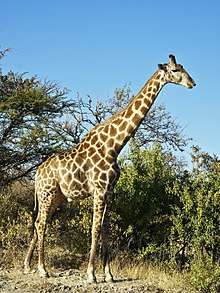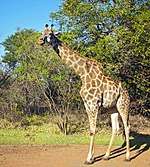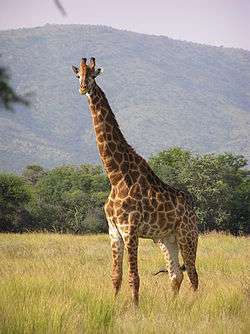Southern giraffe
The southern giraffe (Giraffa giraffa), also known as two-horned giraffe,[1] is a proposed species of giraffe native to Southern Africa.[2] However, the IUCN currently recognizes only one species of giraffe with nine subspecies.[3][4]
- See Giraffe for details on how this proposed taxonomy fits within the currently accepted taxonomy of giraffes.

Southern giraffes have rounded or blotched spots, some with star-like extensions on a light tan background, running down to the hooves. They range from South Africa, Angola, Namibia, Botswana, Zambia, Zimbabwe, Mozambique. Their approximate population is composed of 44,500 individuals.[5]
All giraffes are considered Vulnerable to extinction by the IUCN.[6]
Taxonomy and evolution
Living giraffes were originally classified as one species by Carl Linnaeus in 1758, under the binomial name Cervus camelopardalis. Morten Thrane Brünnich classified the genus Giraffa in 1772.[7] Once considered a subspecies of the conglomerate Giraffa camelopardalis species, recent studies proposed the southern giraffe as a separate species of a reorganised genus Giraffa, under the binomial name Giraffa giraffa.[8][5][9] However, the taxonomic scheme has been criticized, and currently the IUCN recognizes only one species of giraffe with nine subspecies.[3][4]
Subspecies
Two subspecies of southern giraffe are proposed.
| Subspecies | Description | Image |
|---|---|---|
| Angolan giraffe (G. g. angolensis), also known as Namibian giraffe | Is found in northern Namibia, south-western Zambia, Botswana, and western Zimbabwe. A 2009 genetic study on this subspecies suggests the northern Namib Desert and Etosha National Park populations each form a separate subspecies.[10] This subspecies has large brown blotches with edges that are either somewhat notched or have angular extensions. The spotting pattern extends throughout the legs but not the upper part of the face. The neck and rump patches tend to be fairly small. The subspecies also has a white ear patch.[11]:51 Around 13,000 animals are estimated to remain in the wild; and about 20 are kept in zoos.[5] |  |
| South African giraffe (G. g. giraffa), also known as Cape giraffe | Is found in northern South Africa, southern Botswana, southern Zimbabwe, and south-western Mozambique. It has dark, somewhat rounded patches "with some fine projections" on a tawny background colour. The spots extend down the legs and get smaller. The median lump of males is less developed.[11]:52 Approximately 31,500 are estimated to remain in the wild, and around 45 are kept in zoos.[5] |  |
Descriptions
The Cape subspecies of the southern giraffe has dark, somewhat rounded patches "with some fine projections" on a tawny background colour. The spots extend down the legs and get smaller. The median lump of bulls is less developed.[11]:52
Distribution and habitat
The southern giraffes live in the savannahs and woodlands of northern South Africa, Angola, southern Botswana, southern Zimbabwe, Zambia and south-western Mozambique. After local extinctions in various places, the South African giraffes have been reintroduced in many parts of Southern Africa, including in Swaziland. They are common in both inside and outside of protected areas.[6]
Ecology and behavior
Southern giraffes usually live in savannahs and woodlands where food plants are available. Southern giraffes are herbivorous mammals. They feed on leaves, flowers, fruits and shoots of woody plants such as Acacia.
Threats
Southern giraffes are not threatened, as their population is increasing.[6]
References
- Lesson, R. (1842). The Southern or Two-horned giraffe (Giraffa capensis). Existing Forms of Giraffe (February 16, 1897): 14.
- Petzold, Alice; Hassanin, Alexandre (2020-02-13). "A comparative approach for species delimitation based on multiple methods of multi-locus DNA sequence analysis: A case study of the genus Giraffa (Mammalia, Cetartiodactyla)". PLOS ONE. 15 (2): e0217956. doi:10.1371/journal.pone.0217956. ISSN 1932-6203.
- IUCN (2016). "Giraffa camelopardalis: Muller, Z., Bercovitch, F., Brand, R., Brown, D., Brown, M., Bolger, D., Carter, K., Deacon, F., Doherty, J.B., Fennessy, J., Fennessy, S., Hussein, A.A., Lee, D., Marais, A., Strauss, M., Tutchings, A. & Wube, T.". IUCN Red List of Threatened Species. doi:10.2305/iucn.uk.2016-3.rlts.t9194a51140239.en.
- Bercovitch, Fred B.; Berry, Philip S.M.; Dagg, Anne; Deacon, Francois; Doherty, John B.; Lee, Derek E.; Mineur, Frédéric; Muller, Zoe; Ogden, Rob (2017-02-20). "How many species of giraffe are there?". Current Biology. 27 (4): R136–R137. doi:10.1016/j.cub.2016.12.039. ISSN 0960-9822. PMID 28222287.
- Fennessy J.; Bidon T.; Reuss F.; Kumar V.; Elkan P.; Nilsson M.A.; Vamberger M.; Fritz U.; Janke A. (2016). "Multi-locus Analyses Reveal Four Giraffe Species Instead of One". Current Biology. 26 (18): 2543–2549. doi:10.1016/j.cub.2016.07.036. PMID 27618261.
- Muller, Z.; Bercovitch, F.; Brand, R.; Brown, D.; Brown, M.; Bolger, D.; Carter, K.; Deacon, F.; Doherty, J.B.; Fennessy, J.; Fennessy, S.; Hussein, A.A.; Lee, D.; Marais, A.; Strauss, M.; Tutchings, A. & Wube, T. (2016). "Giraffa camelopardalis". IUCN Red List of Threatened Species. 2016: e.T9194A109326950. doi:10.2305/IUCN.UK.2016-3.RLTS.T9194A51140239.en.{{cite iucn}}: error: |doi= / |page= mismatch (help)
- Dagg, A. I. (1971). "Giraffa camelopardalis" (PDF). Mammalian Species. 5 (5): 1–8. doi:10.2307/3503830. JSTOR 3503830.
- Petzold, Alice; Hassanin, Alexandre (2020-02-13). "A comparative approach for species delimitation based on multiple methods of multi-locus DNA sequence analysis: A case study of the genus Giraffa (Mammalia, Cetartiodactyla)". PLOS ONE. 15 (2): e0217956. doi:10.1371/journal.pone.0217956. ISSN 1932-6203.
- Brown, David M.; Brenneman, Rick A.; Koepfli, Klaus-Peter; Pollinger, John P.; Milá, Borja; Georgiadis, Nicholas J.; Louis, Edward E.; Grether, Gregory F.; Jacobs, David K. (2007-01-01). "Extensive population genetic structure in the giraffe". BMC Biology. 5: 57. doi:10.1186/1741-7007-5-57. ISSN 1741-7007. PMC 2254591. PMID 18154651.
- Brenneman, R. A.; Louis, E. E. Jr; Fennessy, J. (2009). "Genetic structure of two populations of the Namibian giraffe, Giraffa camelopardalis angolensis". African Journal of Ecology. 47 (4): 720–28. doi:10.1111/j.1365-2028.2009.01078.x.
- Seymour, R. (2002) The taxonomic status of the giraffe, Giraffa camelopardalis (L. 1758), PH.D Thesis